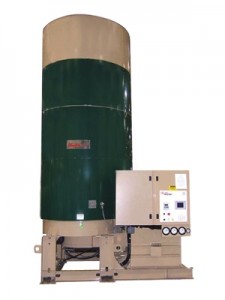
Should you revamp or replace your boiler?
By Glenn Adgey
Facilities MaintenanceConsider a number of factors before deciding to purchase a new boiler, or retrofit an older unit

Steam plays a key role at food process plants — so a reliable, cost-effective and safe boiler is essential. As facilities age, managers eventually must grapple with choosing between upgrading the current boiler or buying a new one.
Your existing boiler may be in good enough condition to justify repair or upgrade. However, that doesn’t mean spending money on it makes sense. You must assess a variety of factors to see if modernizing your unit will suffice. First, review in detail your current steam needs, regulatory requirements, and fuel costs. In many cases, you’ll find marked changes since that boiler was originally installed.
Plant steam profile
You must determine your current steam profile and loads. If load has significantly decreased, your boiler now may be running at a very inefficient, low firing rate. Replacing it with a smaller unit or multiple smaller units might result in substantial savings in fuel costs.

Typical steam generator. Coil-type boilers start up quickly, generating steam in as little as 10 minutes.
On the other hand, your plant load may have increased to the point where your boiler is being run at very high loads and is experiencing hefty maintenance costs. In this case, you might want to consider adding a new unit that can run more efficiently and keep your current boiler as a backup.
A complete and measured load profile over the course of the day’s operation will provide the information needed to make an informed decision. Would one large boiler be best, or would multiple staged units be more effective and efficient?
Regulatory requirements
Local Canadian air regulations may have changed, reducing emissions allowed. Your existing boiler may not be grandfathered at its current levels, and so would require a retrofit. This might mean replacing the entire unit if the manufacturer doesn’t offer just burner replacement. It might mean switching from oil to natural gas. Review of your local provincial rules with a qualified environmental consultant will clarify what rules you now must meet. In general, 10mbu input requires some low NOx attention in Ontario. The emission guidelines are under review and a new NOx BLIER working group is soon to release new guidelines for Canadian federal emissions. The Environment Canada website will have the details!
Rebates
Many Canadian utilities offer financial assistance when plants are upgrading to more efficient boilers. The addition of economizers, linkageless controls and more efficient boilers may receive an incentive from the utilities.
Boiler operators
Many jurisdictions allow high-pressure steam boilers to be operated unattended if they meet certain criteria. This will allow for the reduction or elimination of stationary engineers. Review the current codes in your area as regulatory bodies review and alter the codes on an ongoing basis. Ontario, Manitoba, Quebec and Newfoundland for instance, allow manpower savings for high-pressure steam plants.
Fuel considerations
Fuel is by far the biggest expense in running a steam boiler. So check the cost of fuel and the amount you use. Typically, efficiency improvement alone doesn’t justify a complete boiler replacement. However, coupling that with spending otherwise necessary for a burner retrofit or boiler heat exchanger repair may.
The specifics of your existing equipment and your current and future needs will determine what can be done, what this entails, and the cost.
In many cases a retrofit, that is, modernizing your current boiler, may make the most economic sense. Often it’s easy to justify upgrading the control system with a state-of-the-art programmable logic controller and a new servo-based burner-management system. In addition, adding an economizer is usually a viable way to boost efficiency. However, repairing a boiler that’s too small or inefficient may not be the best use of your capital budget. If you’re looking to change your steam output or pressure, retrofitting generally isn’t possible.
Even if your analysis indicates that you should get a new unit, consider whether it’s worthwhile to do some minor repairs on the old boiler and keep it as a low cost standby. And don’t assume you should buy the same type of boiler.
Types of boilers
Before choosing a new boiler, it’s important to understand the types of units available. Almost all steam boilers are classified either as “fire tube” or “water tube.”
A fire tube boiler is typically a horizontal vessel full of water with tubes running through it. The combustion gas flows through the tubes and heats the water around them. The gas can make from one to four passes through the water, depending upon boiler design. Another variation is the type of insulation, either dry back or wet back, on the end opposite the burner. Typically, fire tube units run up to 1,500 to 2,000 BHP. Larger capacities require a water tube design.
In water tube boilers, the combustion gas flows around the tubes and water flows in them. Units come in a wide range of configurations such as bent tube, A-style, D-Style and O-style, according to the shape of the tube bundles. Another major difference is in how the water circulates inside the unit. Most water tube boilers use natural heat circulation to move water between a vessel at the top, called the steam drum, and a collection manifold at the bottom, called the mud drum.
A third type of boiler, technically a forced-circulation water tube boiler but commonly referred to as a steam generator, uses a mechanical water pump to control and circulate the internal water flow. Tubes are normally configured in a coil shape, so such units often are called “coil type” boilers.
Selection considerations
When purchasing a boiler you should consider a variety of factors:
- Costs – Annual fuel cost to run the unit easily can be five times or more the expense to purchase and install it. So weigh operating costs when comparing prices. The cheapest unit to purchase and install may end up costing you a lot more over a 10-year period. Short-term savings may translate into an inefficient system with high long-term maintenance and repair costs.
- Startup – If you don’t need steam 24/7, you’ll probably want to shut down your boiler at times. Do you need a unit that can stop and start in short order, or is a slower startup acceptable? Every time you start or idle a boiler just to keep it warm, you’re wasting fuel. If quick startups are required, consider a steam generator. These efficient boilers can go from startup to steam generating in about 10 minutes.
- Efficiency – By and large today’s boilers are tremendously more efficient than ever before, thanks to improving technology and tougher government emissions standards. However, you still must pay attention to a boiler’s steam efficiency rating, which can range from about 80 per cent to well above 90 per cent.
- Fuel supply – Boilers use oil, coal, wood and natural gas. Each fuel has its own benefits and pitfalls. They also can vary greatly as to their efficiency. Local emission rules may restrict your options. Natural gas is usually the most convenient to deliver, as it can be piped in directly. However, other fuels may be preferable depending on your location and application.
- Service/maintenance – A boiler usually operates for a long time. It will need servicing or repairs. So always carefully consider vendors’ support and maintenance contract capabilities when buying a unit.
- Safety – Government regulations have made boilers and boiler operation much safer than ever before. But that doesn’t mean accidents can’t happen. Routine inspections, maintenance and troubleshooting are important no matter what type of boiler you own or plan to buy. Always check the safety record of any boiler or boiler type before purchasing to ensure it meets all safety standards and regulations. Look particularly at whether the unit is certified to the American Society of Mechanical Engineers’ Boiler and Pressure Vessel (BPV) Code. To find out if a boiler you are investigating has the BPV certification, visit www.asme.org
- Space Savings – When deciding upon a new boiler consider the footprint not only of the boiler proper, but also of the space required for servicing the boiler.
- Intangibles – Several items that are sometimes difficult to put an actual dollar figure to in a bid comparison can have significant economic impact. For example, how much is factory skid mounting of equipment worth? It not only can cut installation costs but can also save engineering hours on your side. Likewise, the value of service support, parts availability, warranties and performance guarantees
 may be hard to quantify but these are important considerations in choosing a vendor. Buy only from suppliers that can back up the equipment with support.
may be hard to quantify but these are important considerations in choosing a vendor. Buy only from suppliers that can back up the equipment with support.
Glenn Adgey is Toronto-based eastern regional manager for Clayton Industries, Inc. Contact him at glenn.adgey@claytonindustries.com.
Print this page